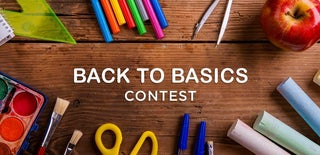Introduction: Cardboard and Velcro Building Tiles
These cardboard Velcero Building Tiles are wonderful for so many reasons. Unlike Magna-Tiles, they don't come crashing down as easily and loudly, which is great news for my classroom. Also because they are held together with Velcro, you can create all kinds of 3D shapes (like the icosahedron in the picture). These building tiles are great for all ages: from pre-k kids who build houses all the way to upper grades who can make complex geometric solids!
Step 1: Materials
You will need:
Thin cardboard (like from cereal boxes)
Thicker corrugated cardboard
Velcro (sticky or non-sticky will work). I used both 1/2 inch and 5/8 of an inch because that's what I happen to have, and both worked fine. For this project, you will need to cut the velcro into 3/4 inch pieces.
Strong adhesive (if you don't use sticky velcro, or even if you do, for extra staying power)
Elmer's -type glue
Glue stick
Small binder clips
Scissors
For decorating your tiles, you might use:
old calendars, scraps of wrapping paper, colorful construction paper, magazines, blank paper and markers; or any other interesting scrap paper you have lying around. Or, you can use blank paper and paint or draw your own decorations.
Step 2: Make a Stencil
(I'm going to take you through the steps to make one tile of one shape, just to explain the process. I've been making several at once, and I've included in the template download some combined shapes that I've been using in order to mass produce. I think you'll find that as soon as you start playing with these you are going to want more and more)
1. Download and print the Cardboard Tile Template.
2. Cut out the shape you want to work on and glue it (glue stick is fine) to thin cardboard.
3. Cut the out the cardboard shape with the paper glued on.
Attachments
Step 3: Trace and Cut
Using your stencil, trace and cut out 3 layers: 2 of thin cardboard and 1 of thicker, corrugated cardboard.
(Note: if you are doing this project with kids making the tiles, you can use 4 layers of thin cardboard and forgo the thicker cardboard. I've learned that cutting thick cardboard can be tough and frustrating for younger kids to cut out accurately.)
Step 4: Glue Layers Together
Smear Elmers-type glue all over the thick cardboard and one of the thin cardboards. Make sure to get the glue all the way to the edges. Make a sandwich (thin, thick, thin) and clamp them together with binder clips. Let them dry.
If you are making several at once, your floor will look like this!
Step 5: Add Decorative Paper
Meanwhile, using your stencil, trace and cut out 2 tile-shapes of decorative paper. Glue them on to both sides, using a glue stick. Clamp with binder clips. If you are making a lot at once, now your floor will look like this!
Step 6: Glue on Velcro
1. Separate the hook and loop parts of the velcro.
2. On each side of your shape, glue one hook and one loop. As you continue around your shape, also continue the pattern: hook, loop, hook, loop, hook, loop (see diagram). This is very important because it eventually allows all the shapes to join together. If you are using sticky velcro, depending on the stickiness, you might be able to get away with just sticking it on the cardboard without using the strong adhesive (Goop, for example). If the velcro falls when you are building with the tiles, you can always add the adhesive later.
I like doing one side at a time, letting it dry and then gluing the other side.
Then, as always, clamp with binder clips.
Step 7:
This project takes a lot of time and will deplete your Velcro stash, but it is so worth it! It's really fun to watch kids figure out different ways to put together the shapes. As a teacher, my favorite words to hear are, "Look what I made!" and these building tiles provide plenty of opportunities for this enthusiastic exclamation.
Here are a couple of photos to show how to make some interesting shapes. If you google, "geometric solids" you will find many more. And maybe discover some of your own!
I'm always looking for ways to do cross-grade-level activities, and whenever we get back to school I'm going have the upper grades make a set of these building tiles for the younger grades.

Second Prize in the
Back to Basics Contest












